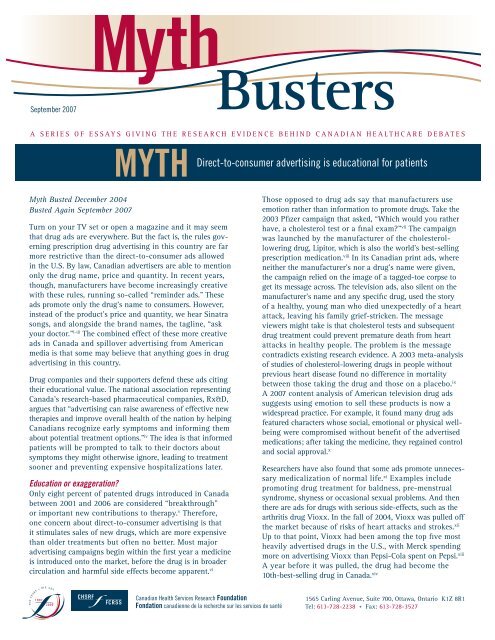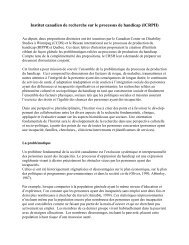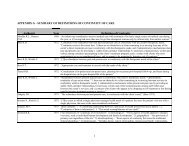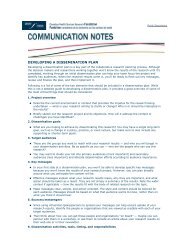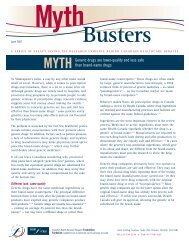Direct-to-consumer advertising is educational for patients
Direct-to-consumer advertising is educational for patients
Direct-to-consumer advertising is educational for patients
You also want an ePaper? Increase the reach of your titles
YUMPU automatically turns print PDFs into web optimized ePapers that Google loves.
September 2007<br />
Busters<br />
A s e r i e s o f e s s ay s g i v i n g t h e r e s e a r c h e v i d e n c e b e h i n d C a n a d i a n h e a l t h c a r e d e b a t e s<br />
MYTH<br />
<strong>Direct</strong>-<strong>to</strong>-<strong>consumer</strong> <strong>advert<strong>is</strong>ing</strong> <strong>is</strong> <strong>educational</strong> <strong>for</strong> <strong>patients</strong><br />
Myth Busted December 2004<br />
Busted Again September 2007<br />
Turn on your TV set or open a magazine and it may seem<br />
that drug ads are everywhere. But the fact <strong>is</strong>, the rules governing<br />
prescription drug <strong>advert<strong>is</strong>ing</strong> in th<strong>is</strong> country are far<br />
more restrictive than the direct-<strong>to</strong>-<strong>consumer</strong> ads allowed<br />
in the U.S. By law, Canadian advert<strong>is</strong>ers are able <strong>to</strong> mention<br />
only the drug name, price and quantity. In recent years,<br />
though, manufacturers have become increasingly creative<br />
with these rules, running so-called “reminder ads.” These<br />
ads promote only the drug’s name <strong>to</strong> <strong>consumer</strong>s. However,<br />
instead of the product’s price and quantity, we hear Sinatra<br />
songs, and alongside the brand names, the tagline, “ask<br />
your doc<strong>to</strong>r.” i-iii The combined effect of these more creative<br />
ads in Canada and spillover <strong>advert<strong>is</strong>ing</strong> from American<br />
media <strong>is</strong> that some may believe that anything goes in drug<br />
<strong>advert<strong>is</strong>ing</strong> in th<strong>is</strong> country.<br />
Drug companies and their supporters defend these ads citing<br />
their <strong>educational</strong> value. The national association representing<br />
Canada’s research-based pharmaceutical companies, Rx&D,<br />
argues that “<strong>advert<strong>is</strong>ing</strong> can ra<strong>is</strong>e awareness of effective new<br />
therapies and improve overall health of the nation by helping<br />
Canadians recognize early symp<strong>to</strong>ms and in<strong>for</strong>ming them<br />
about potential treatment options.” iv The idea <strong>is</strong> that in<strong>for</strong>med<br />
<strong>patients</strong> will be prompted <strong>to</strong> talk <strong>to</strong> their doc<strong>to</strong>rs about<br />
symp<strong>to</strong>ms they might otherw<strong>is</strong>e ignore, leading <strong>to</strong> treatment<br />
sooner and preventing expensive hospitalizations later.<br />
Education or exaggeration?<br />
Only eight percent of patented drugs introduced in Canada<br />
between 2001 and 2006 are considered “breakthrough”<br />
or important new contributions <strong>to</strong> therapy. v There<strong>for</strong>e,<br />
one concern about direct-<strong>to</strong>-<strong>consumer</strong> <strong>advert<strong>is</strong>ing</strong> <strong>is</strong> that<br />
it stimulates sales of new drugs, which are more expensive<br />
than older treatments but often no better. Most major<br />
<strong>advert<strong>is</strong>ing</strong> campaigns begin within the first year a medicine<br />
<strong>is</strong> introduced on<strong>to</strong> the market, be<strong>for</strong>e the drug <strong>is</strong> in broader<br />
circulation and harmful side effects become apparent. vi<br />
Those opposed <strong>to</strong> drug ads say that manufacturers use<br />
emotion rather than in<strong>for</strong>mation <strong>to</strong> promote drugs. Take the<br />
2003 Pfizer campaign that asked, “Which would you rather<br />
have, a cholesterol test or a final exam?” vii The campaign<br />
was launched by the manufacturer of the cholesterollowering<br />
drug, Lipi<strong>to</strong>r, which <strong>is</strong> also the world’s best-selling<br />
prescription medication. viii In its Canadian print ads, where<br />
neither the manufacturer’s nor a drug’s name were given,<br />
the campaign relied on the image of a tagged-<strong>to</strong>e corpse <strong>to</strong><br />
get its message across. The telev<strong>is</strong>ion ads, also silent on the<br />
manufacturer’s name and any specific drug, used the s<strong>to</strong>ry<br />
of a healthy, young man who died unexpectedly of a heart<br />
attack, leaving h<strong>is</strong> family grief-stricken. The message<br />
viewers might take <strong>is</strong> that cholesterol tests and subsequent<br />
drug treatment could prevent premature death from heart<br />
attacks in healthy people. The problem <strong>is</strong> the message<br />
contradicts ex<strong>is</strong>ting research evidence. A 2003 meta-analys<strong>is</strong><br />
of studies of cholesterol-lowering drugs in people without<br />
previous heart d<strong>is</strong>ease found no difference in mortality<br />
between those taking the drug and those on a placebo. ix<br />
A 2007 content analys<strong>is</strong> of American telev<strong>is</strong>ion drug ads<br />
suggests using emotion <strong>to</strong> sell these products <strong>is</strong> now a<br />
widespread practice. For example, it found many drug ads<br />
featured characters whose social, emotional or physical wellbeing<br />
were comprom<strong>is</strong>ed without benefit of the advert<strong>is</strong>ed<br />
medications; after taking the medicine, they regained control<br />
and social approval. x<br />
Researchers have also found that some ads promote unnecessary<br />
medicalization of normal life. xi Examples include<br />
promoting drug treatment <strong>for</strong> baldness, pre-menstrual<br />
syndrome, shyness or occasional sexual problems. And then<br />
there are ads <strong>for</strong> drugs with serious side-effects, such as the<br />
arthrit<strong>is</strong> drug Vioxx. In the fall of 2004, Vioxx was pulled off<br />
the market because of r<strong>is</strong>ks of heart attacks and strokes. xii<br />
Up <strong>to</strong> that point, Vioxx had been among the <strong>to</strong>p five most<br />
heavily advert<strong>is</strong>ed drugs in the U.S., with Merck spending<br />
more on <strong>advert<strong>is</strong>ing</strong> Vioxx than Pepsi-Cola spent on Pepsi. xiii<br />
A year be<strong>for</strong>e it was pulled, the drug had become the<br />
10th-best-selling drug in Canada. xiv<br />
1565 Carling Avenue, Suite 700, Ottawa, Ontario K1Z 8R1<br />
Tel: 613-728-2238 * Fax: 613-728-3527
Other research evidence suggests prescription drug ads exaggerate<br />
benefits and downplay r<strong>is</strong>ks. It also finds that they<br />
don’t d<strong>is</strong>cuss non-drug treatments that may be available,<br />
prevalence of the illness or the success rate of the drug<br />
compared <strong>to</strong> a test group that <strong>to</strong>ok a placebo. By law,<br />
American ads must include in<strong>for</strong>mation about a drug’s<br />
side effects, who should and shouldn’t take the medicine,<br />
and overdoses. However, that in<strong>for</strong>mation <strong>is</strong> usually in small<br />
type in print ads, and TV ads often present the in<strong>for</strong>mation<br />
<strong>to</strong>o quickly <strong>to</strong> digest. xv-xviii<br />
Ask your doc<strong>to</strong>r<br />
Drug companies and their supporters argue that direct-<strong>to</strong><strong>consumer</strong><br />
ads start a conversation between <strong>patients</strong> and<br />
their doc<strong>to</strong>rs. Indeed, they do. And many of those <strong>patients</strong><br />
who ask their doc<strong>to</strong>r walk away with a prescription.<br />
The authors of a 2005 randomized trial in the U.S. found<br />
“standardized <strong>patients</strong>” — trained ac<strong>to</strong>rs pretending <strong>to</strong> be<br />
<strong>patients</strong> — who asked <strong>for</strong> an advert<strong>is</strong>ed drug were likely <strong>to</strong><br />
get a prescription <strong>for</strong> it, whether they showed symp<strong>to</strong>ms<br />
of the illness the drug treated or not. xix Meanwhile, doc<strong>to</strong>rs<br />
worry about spending their limited time “re-educating”<br />
<strong>patients</strong>, explaining why a certain drug <strong>is</strong>n’t appropriate<br />
xv, xviii<br />
<strong>for</strong> them or why a non-drug treatment may be better.<br />
Worth the cost?<br />
A 2007 study that compared spending on pharmaceutical<br />
drugs in the U.S. and Canada estimates that if Canada had<br />
followed the American lead in allowing these ads, it would<br />
be spending $10 billion more per year on prescription<br />
medicines than it currently does. xx<br />
Th<strong>is</strong> study, combined with a 2005 systematic review that<br />
found no evidence that direct-<strong>to</strong>-<strong>consumer</strong> <strong>advert<strong>is</strong>ing</strong><br />
leads <strong>to</strong> health benefits, xxi suggests the costs of opening the<br />
door <strong>to</strong> these less restrictive ads — both in dollars and r<strong>is</strong>ks<br />
— <strong>is</strong> not worth the possible benefits, unless they profiled<br />
appropriate and cost-effective treatments. xx<br />
Conclusion<br />
Manufacturers have put their faith in direct-<strong>to</strong>-<strong>consumer</strong><br />
<strong>advert<strong>is</strong>ing</strong>, spending $4.8 billion in the U.S. last year alone. xxii<br />
<strong>Direct</strong>-<strong>to</strong>-<strong>consumer</strong> <strong>advert<strong>is</strong>ing</strong> has proven effective in selling<br />
medicines and boosting profits, xxiii but not educating the<br />
public. To promote safe, effective and efficient medicine use,<br />
policy makers may be well-adv<strong>is</strong>ed <strong>to</strong> maintain restrictions<br />
on direct-<strong>to</strong>-<strong>consumer</strong> <strong>advert<strong>is</strong>ing</strong> and <strong>to</strong> invest in publicly<br />
sponsored campaigns — independent of manufacturers<br />
— that deliver reliable and comparative health in<strong>for</strong>mation<br />
<strong>to</strong> the public. xxiv<br />
References<br />
i. Brown B. 2004. “Opening the medicine cabinet: first report on health aspects of<br />
prescription drugs.” Report of the standing committee on health. http://cmte.parl.<br />
gc.ca/cmte/CommitteePublication.aspx?COM=8791&Lang=1&SourceId=76297<br />
ii. Gardner DM, Mintzes B, and Ostry A. 2003. “<strong>Direct</strong>-<strong>to</strong>-<strong>consumer</strong> prescription<br />
drug <strong>advert<strong>is</strong>ing</strong> in Canada: Perm<strong>is</strong>sion by default?”<br />
Canadian Medical Association Journal; 169(5): 425-427.<br />
iii. Health Canada. 2000 (updated 2005). “Advert<strong>is</strong>ing campaigns of branded and<br />
unbranded messages.” Policy Statement. www.hc-sc.gc.ca/dhp-mps/alt_<strong>for</strong>mats/<br />
hpfb-dgpsa/pdf/advert-publicit/advert-pub_camp_final_2005-08_e.pdf<br />
iv. Canada’s Research-Based Pharmaceutical Companies. 2007. “Position papers<br />
— Advert<strong>is</strong>ing prescription medicine in Canada: Why it makes sense.”<br />
www.canadapharma.org/Media/Papers/dtca_e.html (accessed March 3, 2007)<br />
v. Patented Medicine Prices Review Board. 2007. “Annual report.”<br />
www.pmprb-cepmb.gc.ca/CMFiles/PMPRB-AR06-en38FDK-7192007-4985.pdf<br />
vi. Donahue JM et al. 2007. “A decade of direct-<strong>to</strong>-<strong>consumer</strong> <strong>advert<strong>is</strong>ing</strong> of<br />
prescription drugs.” New England Journal of Medicine; 357: 673-681.<br />
vii. Mintzes B. 2006. “D<strong>is</strong>ease mongering in drug promotion: Do governments<br />
have a regula<strong>to</strong>ry role?” PLoS Medicine; 3(4): 0461-0465 (e198).<br />
viii. CBC. 2006. Canadian court halts generic Lipi<strong>to</strong>r launch: Pfizer.<br />
www.cbc.ca/money/s<strong>to</strong>ry/2006/12/08/pfizer.html<br />
ix. Therapeutics Initiative. 2003. “Do statins have a role in primary prevention?”<br />
Therapeutics Letter #48. www.ti.ubc.ca/PDF/48.pdf<br />
x. Frosch DL et al. 2007. “Creating demand <strong>for</strong> prescription drugs: A content analys<strong>is</strong><br />
of telev<strong>is</strong>ion direct-<strong>to</strong>-<strong>consumer</strong> <strong>advert<strong>is</strong>ing</strong>.” Annals of Family Medicine; 5(1):<br />
6-13.<br />
xi. Woloshin S and Scwartz LM. 2006. “Giving legs <strong>to</strong> restless legs: A case study<br />
of how the media helps make people sick.” PLoS Medicine; 3(4): 0452-0455<br />
(e170).<br />
xii. Merck & Co. 2004. “Merck announces voluntary worldwide withdrawal of<br />
Vioxx.” Press Release. www.vioxx.com/vioxx/documents/engl<strong>is</strong>h/vioxx_press_<br />
release.pdf.<br />
xiii. Mintzes B. 2006. “What are the public health implications? <strong>Direct</strong>-<strong>to</strong>-<strong>consumer</strong><br />
<strong>advert<strong>is</strong>ing</strong> of prescription drugs in Canada.” www.healthcouncilcanada.ca/docs/<br />
papers/2006/hcc_dtc-<strong>advert<strong>is</strong>ing</strong>_200601_e_v6.pdf<br />
xiv. IMS Health Canada. 2003. Compuscript.<br />
xv. Roth MS. 1996. “Patterns in direct-<strong>to</strong>-<strong>consumer</strong> prescription drug print<br />
<strong>advert<strong>is</strong>ing</strong> and their public policy implications.” Journal of Public Policy<br />
and Marketing; 15(1): 63-75.<br />
xvi. Woloshin S et al. 2001. “<strong>Direct</strong>-<strong>to</strong>-<strong>consumer</strong> advert<strong>is</strong>ements <strong>for</strong> prescription<br />
drugs: what are Americans being sold?” The Lancet; 358(9288): 1141-1146.<br />
xvii. Bell RA, Wilkes MS, and Kravitz RL. 2000. “The <strong>educational</strong> value of <strong>consumer</strong>targeted<br />
prescription drug print <strong>advert<strong>is</strong>ing</strong>.” Journal of Family Practice; 49(12):<br />
1092-1098.<br />
xviii. Lexchin J and Mintzes B. 2002. “<strong>Direct</strong>-<strong>to</strong>-<strong>consumer</strong> <strong>advert<strong>is</strong>ing</strong> of<br />
prescription drugs: the evidence says no.” Journal of Public Policy<br />
and Marketing; 21(2): 194-201.<br />
xix. Kravitz RL et al. 2005. “Influence of <strong>patients</strong>’ requests <strong>for</strong> direct-<strong>to</strong>-<strong>consumer</strong><br />
advert<strong>is</strong>ed antidepressants: A randomized controlled trial.” Journal of the<br />
American Medical Association; 293(16): 1995-2002.<br />
xx. Morgan SG. 2007. “<strong>Direct</strong>-<strong>to</strong>-<strong>consumer</strong> <strong>advert<strong>is</strong>ing</strong> and expenditures on<br />
prescription drugs: A compar<strong>is</strong>on of experiences in the United States<br />
and Canada.” Open Medicine; 1(1): e37-45.<br />
xxi. Gilbody S, Wilson P, and Watt I. 2005. “Benefits and harms of direct <strong>to</strong> <strong>consumer</strong><br />
<strong>advert<strong>is</strong>ing</strong>: A systematic review.” Quality and Safety in Healthcare; 14(4):<br />
246-250.<br />
xxii. Flood C and Zimmerman M. 2006. “<strong>Direct</strong>-<strong>to</strong>-<strong>consumer</strong> <strong>advert<strong>is</strong>ing</strong>: CanWest’s<br />
Charter Challenge.” In IHSPR Research Spotlight Pharmaceutical Research<br />
and Policy. www.cihr-irsc.gc.ca/e/32055.html<br />
xxiii. The Ka<strong>is</strong>er Family Foundation. 2003. “Impact of <strong>Direct</strong>-<strong>to</strong>-Consumer Advert<strong>is</strong>ing<br />
on Prescription Drug Spending.” www.kff.org/rxdrugs/upload/Impact-of-<strong>Direct</strong>-<strong>to</strong>-<br />
Consumer-Advert<strong>is</strong>ing-on-Prescription-Drug-Spending-Summary-of-Findings.pdf<br />
xxiv. Joint Declaration of HAI Europe, ISDB, AIM, BEUC, Medicines in Europe Forum.<br />
2006. “Relevant health in<strong>for</strong>mation <strong>for</strong> empowered citizens.”<br />
www.haiweb.org/01102006/PatientIn<strong>for</strong>mationDeclaration.pdf<br />
Myth Busters <strong>is</strong> prepared by knowledge transfer and exchange<br />
staff at the Canadian Health Services Research Foundation<br />
and publ<strong>is</strong>hed only after review by experts on the <strong>to</strong>pic.


